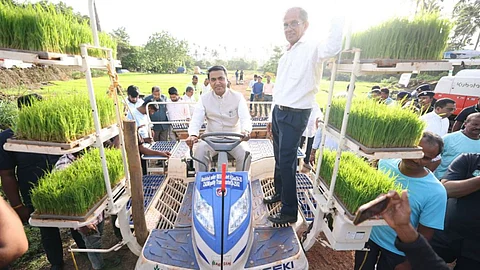

Goa’s traditional cuisine is amazing, and no visitor to the State leaves with tasting it. And, this cuisine goes best with rice. Incidentally, rice is the staple food across most of Asia, including the Far East, Southeast Asia, and the Indian subcontinent, also known as South Asia. Only the desert regions of the Middle East have different dietary habits.
The economic blockade of 1954–61 taught the people of Goa the true meaning of ‘Swayampoorna’ or self-sufficiency — like no other event before or since. You either grew your own food or starved.
The new reality is that you either grow your own food or risk consuming the pesticides heavily used in conventional farming, most of which can have a range of adverse effects on human health.
The Government of Goa has strongly backed Fr George Quadros, sdb, the Goencho Xetkar, Vividha Cooperative, and Farmers Clubs statewide to revive rice cultivation in fallow fields.
It’s time to embrace swayampoorna, self-sufficiency. For the Xit-koddi-nustem loving Goans, the most important item of food is rice. We need to grow it. Goans may be called ‘Goemche Pao’ but we do not live on bread alone, and so, the verse is better paraphrased thus, ‘By the sweat of thy brow thou shall earn thy rice.’
The new reality is that you either grow your own food or risk consuming the pesticides heavily used in conventional farming, most of which can have a range of adverse effects on human health.
Grow rice, we must! Youth are joining the movement with such enthusiasm that they’re proving wrong the old armchair ‘experts’ who once claimed, “The youth are not willing to work in the fields.”
An increasing number of young professionals — even engineer — are stepping into agriculture. In Salcete, Goa, local agri graduate Joyd Simoes and his brother, an auto engineer, have teamed up to provide farming services using tractors, a transplanter, and a drone sprayer.
Except for the salt-tolerant Korgut and Asgo in the khazan land, most of the heirloom varieties of rice, such as Damgo, Kochri, Patni, Sotti, etc have long been forgotten, except for a seed bank in Mayem-Sikeri, the ICAR-CCARI at Ela, Old Goa and a few farmers.
Farmers in Raia, South Goa, cultivate the salt-tolerant, awned grain variety Asgo across an entire khazan field located just beyond the Rachol seminary. Dr K K Manohara, the rice breeder at ICAR-CCARI, has been working on the Korgut rice variety for many years, and has developed two ‘pure lines’ – Goa Dhan-1 (KS-12) of white grain, and Goa Dhan-2 (KS-17) of red kernel – both with a yield of about 2.6 tonnes per hectare.
He has additionally developed a hybrid variety with Jyoti rice, named Goa Dhan-4 or JK. With a new plant breeder joining him in Old Goa, further progress in rice cultivation looks promising.
Farmers in Raia, South Goa, cultivate the salt-tolerant, awned grain variety Asgo across an entire khazan field located just beyond the Rachol seminary.
Farming is a noble and respectable profession that deserves the involvement of young professionals. Today, there's a growing sense of pride in returning to the land and embracing agriculture once again.
Now, the Chief Minister of Goa, Pramod Sawant, has thrown his weight behind revitalizing the Khazan fields. The establishment of a new College of Agriculture in Goa has brought fresh hope to the state, even though the original institution closed down prematurely.
The legacy has been passed on — mainly to the faculty, non-teaching staff, and students of the successor college.
A College of Fisheries at Daujim near Old Goa and a College of Veterinary & Animal Sciences at Curti are also set to open soon. It gives me great satisfaction to see young people making significant progress, even with minimal encouragement from the older generations. The youth are embracing farming as naturally as fish take to water.
(The author is the former Chairman of the GCCI Agriculture Committee, CEO of Planter's Choice Pvt Ltd, Additional Director of OFAI and Garden Superintendent of Goa University, and has edited 18 books for Goa & Konkan).